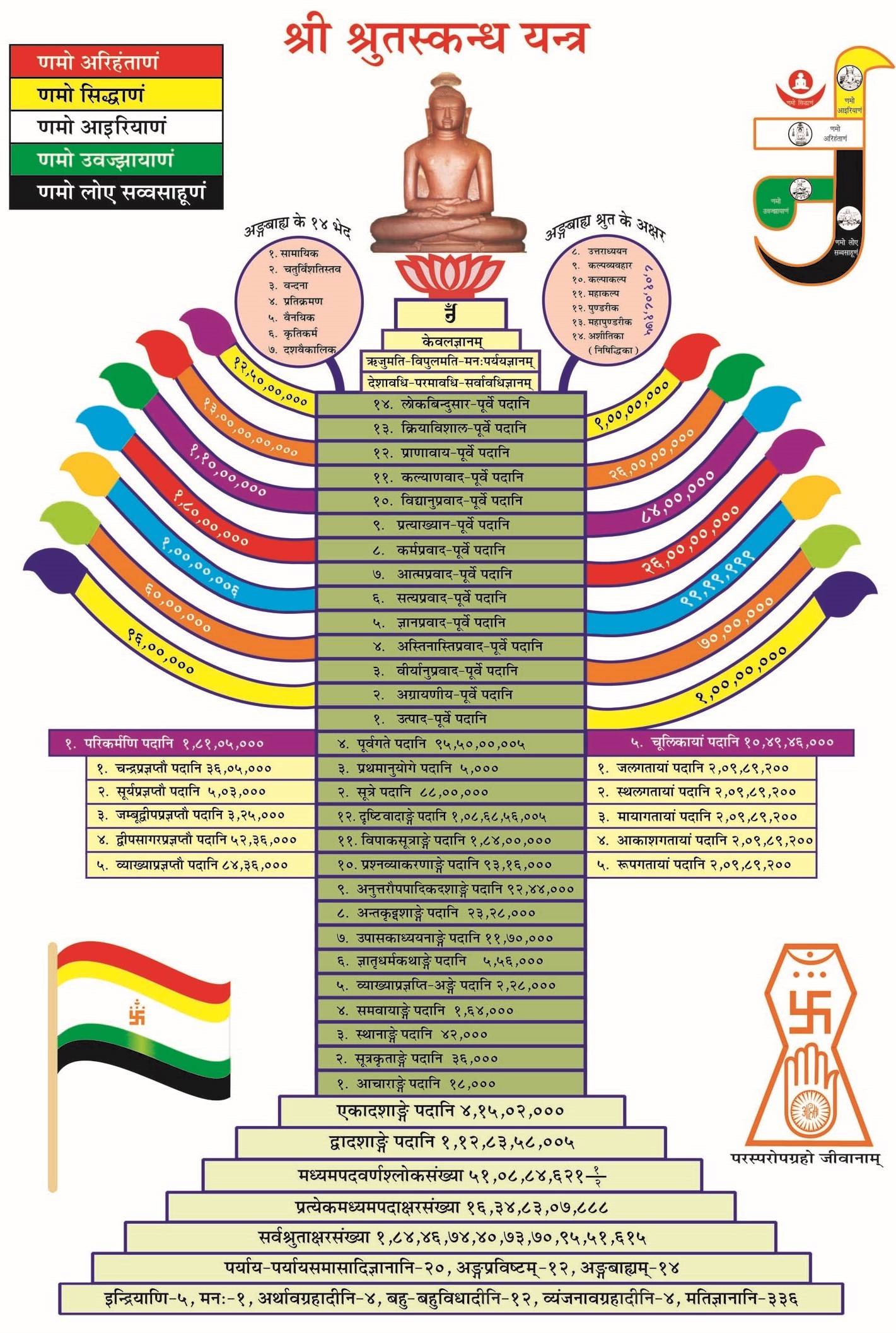nikkyjain@gmail.com
Date : 25-Apr-2023
Index
अधिकार
Index

!! श्रीसर्वज्ञवीतरागाय नम: !!
श्रीमद्-भगवन्नेमिचन्द्र-प्रणीत
श्री
द्रव्यसंग्रह
मूल सौरसेणी प्राकृत गाथा और ब्रह्मदेव-सूरि कृत टीका सहित
आभार : पद्यानुवाद : आ. डाॅ. हुकमचंद भारिल्ल
🏠
!! नम: श्रीसर्वज्ञवीतरागाय !!
ओंकारं बिन्दुसंयुक्तं नित्यं ध्यायन्ति योगिनः
कामदं मोक्षदं चैव ॐकाराय नमो नम: ॥1॥
अविरलशब्दघनौघप्रक्षालितसकलभूतलकलंका
मुनिभिरूपासिततीर्था सरस्वती हरतु नो दुरितान् ॥2॥
अज्ञानतिमिरान्धानां ज्ञानाञ्जनशलाकया
चक्षुरुन्मीलितं येन तस्मै श्रीगुरवे नम: ॥3॥
॥ श्रीपरमगुरुवे नम:, परम्पराचार्यगुरुवे नम: ॥
सकलकलुषविध्वंसकं, श्रेयसां परिवर्धकं, धर्मसम्बन्धकं, भव्यजीवमन: प्रतिबोधकारकं, पुण्यप्रकाशकं, पापप्रणाशकमिदं शास्त्रं श्री-द्रव्यसंग्रह नामधेयं, अस्य मूल-ग्रन्थकर्तार: श्री-सर्वज्ञ-देवास्तदुत्तर-ग्रन्थ-कर्तार: श्री-गणधर-देवा: प्रति-गणधर-देवास्तेषां वचनानुसार-मासाद्य आचार्य श्री-नेमिचंद्र-देव विरचितं ॥
॥ श्रोतार: सावधानतया शृणवन्तु ॥
मंगलं भगवान् वीरो मंगलं गौतमो गणी
मंगलं कुन्दकुन्दार्यो जैनधर्मोऽस्तु मंगलम् ॥
सर्वमंगलमांगल्यं सर्वकल्याणकारकं
प्रधानं सर्वधर्माणां जैनं जयतु शासनम् ॥
सुध्यान में लवलीन हो जब, घातिया चारों हने ।
सर्वज्ञ बोध विरागता को, पा लिया तब आपने ॥
उपदेश दे हितकर अनेकों, भव्य निज सम कर लिये ।
रविज्ञान किरण प्रकाश डालो, वीर! मेरे भी हिये ॥
स्याद्वाद, नय, षट् द्रव्य, गुण, पर्याय और प्रमाण का ।
जड़कर्म चेतन बंध का, अरु कर्म के अवसान का ॥
कहकर स्वरूप यथार्थ जग का, जो किया उपकार है ।
उसके लिये जिनवाणी माँ को, वंदना शत बार है ॥
नि:संग हैं जो वायुसम, निर्लेप हैं आकाश से ।
निज आत्म में ही विहरते, जीवन न पर की आस से ॥
जिनके निकट सिंहादि पशु भी, भूल जाते क्रूरता ।
उन दिव्य गुरुओं की अहो! कैसी अलौकिक शूरता ॥
🏠
शुद्धं प्रबुद्धं वसुकर्ममुक्तं,
निःसीमज्ञानादिकशक्तियुक्तम् ।
भव्येषु नन्द्यं भुवनेषु वन्द्यं,
अजितं जिनेशं प्रणमामि नित्यम् ॥ब्र.दे.सू.॥
प्रणम्य परमात्मानं सिद्धं त्रैलोक्यवन्दितं,
स्वाभाविक चिदानंदस्वरूपं निर्मलाव्ययम् ॥१॥
शुद्धजीवादि द्रव्याणां देशकं च जिनेश्वरं,
द्रव्यसंग्रहसूत्राणां वृत्तिं वक्ष्ये समासतः ॥२॥ युगमं
🏠
मंगलाचरण
जीवमजीवं दव्वं, जिणवरवसहेण जेण णिद्दिट्ठं
देविंदविंदवंदं, वंदे तं सव्वदा सिरसा ॥1॥
Meaning : I make obeisance humble, always by bowing my head, to that supreme Lord Jina who has expounded the reality of substances – souls and non-souls – and who is worshipped by the congregation of the lords of celestial beings .
🏠
छह-द्रव्य अधिकार
जीवो उवओगमओ, अमुत्तिकत्ता सदेहपरिमाणो
भोत्ता संसारत्थो, सिद्धो सो विस्ससोड्ढगई ॥2॥
Meaning : Jiva is characterized by consciousness that is concomitant with upayoga – perception and knowledge , is incorporeal , a causal agent , coextensive with the body, enjoyer of the fruits of karmas , having the world as its abode, emancipated , and of the nature of darting upwards.
🏠
तिक्काले चदुपाणा, इंदिय बलमाउ आणपाणो य
ववहारा सो जीवो, णिच्चयणयदोदु चेदणाजस्स ॥3॥
Meaning : From the empirical or phenomenal point of view , that which is living at present, will continue to live in the future, and was living in the past, through its four principles of organism , is the jīva. From the transcendental or noumenal point of view , that which has consciousness is the jīva.
🏠
उवओगो दुवियप्पो, दंसण णाणं च दंसणं चदुधा
चक्खु अचक्खू ओही, दंसणमध केवलं णेयं ॥4॥
Meaning : Upayoga is of two kinds – perception , and knowledge . Perception is of four kinds – ocular perception , non-ocular intuition , clairvoyant perception , and perfect, infinite perception .
🏠
णाणं अट्ठवियप्पं, मदिसुदओही अणाणणाणाणी
मणपज्जयकेवलमवि, पच्चक्ख परोक्खभेयं च ॥5॥
Meaning : Knowledge is of eight kinds sensory knowledge , scriptural knowledge , clairvoyance , these three, sensory knowledge, scriptural knowledge, and clairvoyance, may also be erroneous knowledge when these coexist in the soul with wrong belief, telepathy , and omniscience .Knowledge consciousness can also be divided into direct and indirect knowledge.
🏠
अट्ठचदुणाण दंसण, सामण्णं जीवलक्खणं भणियं
ववहारा सुद्धणया, सुद्धं पुण दंसणं णाणं ॥6॥
Meaning : From the empirical point of view , eight kinds of knowledge and four kinds of perception are generally said to be the possessions of the soul. And from the pure transcendental point of view , soul’s distinctive characteristic is pure knowledge and perception.
🏠
वण्ण रस पंच गंधा, दो फासा अट्ठणिच्चया जीवे
णो संति अमुत्ति तदो, ववहारा मुत्ति बंधादो ॥7॥
Meaning : As per the transcendental point of view , the soul is devoid of five colours, five kinds of taste, two kinds of smell, and eight kinds of touch and, therefore, it is incorporeal. When it is sullied with the karmic dirt, only then, from the empirical point of view , the soul is said to be having corporeal form.
🏠
पुग्गलकम्मादीणं, कत्ता ववहारदो दु णिच्चयदो
चेदणकम्माणादा, सुद्धणया सुद्धभावाणं ॥8॥
Meaning : From the empirical point of view , the soul is said to be the producer of karmic matter ; from the impure transcendental point of view , the soul is responsible for its psychic dispositions ; but from the pure transcendental point of view , the soul is consciousness – pure perception and knowledge.
🏠
ववहारा सुहदुक्खं, पुग्गलकम्मप्फलं पभुंजेदि
आदा णिच्चयणयदो, चेदणभावं खु आदस्स ॥9॥
Meaning : From the empirical point of view , the soul is said to be the enjoyer of the fruits of karmas in the form of pleasure and pain, but from the transcendental point of view , the soul experiences only consciousness , concomitant with perception and knowledge .
🏠
अणुगुरुदेह-पमाणो, उवसंहारप्पसप्पदो चेदा
असमुहदो ववहारा, णिच्चयणयदोअसंखदेसो वा ॥10॥
Meaning : From the empirical point of view the soul, in states other than that of samudgh ta, due to its capacity of expansion and contraction, is co-extensive with the physical body that it inhabits, but from the transcendental point of view , the soul has innumerable space-points.
🏠
पुढविजलतेउवाऊ, वणप्फदी विविहथावरेइंदी
विगतिगचदुपंचक्खा, तसजीवा होंति संखादी ॥11॥
Meaning : Souls having earth, water, fire, air, and plants for their bodies are various kinds of immobile beings, sthavara jivas, that possess one sense only. The mobile beings, trasa jīvas, like conch etc., progressively possess two, three, four, and five senses.
🏠
समणा अमणा णेया, पंचिंदिय णिम्मणा परे सव्वे
बादरसुहुमेइंदी, सव्वे पज्जत्त इदरा य ॥12॥
Meaning : The five-sensed jivas are categorized as those with mind , and those without mind . Rest all jīvas are without mind. The one-sensed jīvas are categorized as gross , and subtle . All jīvas are further categorized as having attained completion , and not having attained completion .
🏠
मग्गणगुणठाणेहिंय, चउदसहिंह-वंतितहअसुद्धणया
विण्णेया संसारी, सव्वे सुद्धा हु सुद्धणया ॥13॥
Meaning : The transmigrating souls , from the empirical point of view , are of fourteen kinds based on the method of inquiry into their nature , also of fourteen kinds based on their stage of spiritual development . From the transcendental point of view , however, all souls are intrinsically pure.
🏠
णिक्कम्मा अट्ठगुणा,किंचूणा चरमदेहदो सिद्धा
लोयग्गठिदा णिच्चा, उप्पादवयेहिं संजुत्ता ॥14॥
Meaning : The liberated souls are rid of eight kinds of karmas, possessed of eight qualities, have a form slightly less than that of the last body, reside eternally at the summit of the universe, and characterized by origination and destruction .
🏠
अज्जीवो पुणणेओ, पुग्गल धम्मो अधम्म आयासं
कालो पुग्गल मुत्तो, रूवादिगुणो अमुत्ति सेसादु ॥15॥
Meaning : Again, matter , the medium of motion , the medium of rest , space , and time , should be known as non-soul substances. Matter is material object since it has qualities including form , and the remaining are without form.
🏠
सद्दो बंधो सुहुमो, थूलो संठाणभेदतमछाया
उज्जोदादवसहिया, पुग्गल दव्वस्स पज्जाया ॥16॥
Meaning : Sound, union, minuteness , grossness, form , division, darkness, image , cool light , and warm light , are the modes of matter.
🏠
गइपरिणयाण धम्मो, पुग्गलजीवाण गमणसहयारी
तोयं जह मच्छाणं, अच्छंता णेव सो णेई ॥17॥
Meaning : The substance dharma renders assistance to souls and matter in their state of motion, just as water assists aquatic animals in their motion; it does not cause them to move if they are stationary.
🏠
ठाणजुदाण अधम्मो, पुग्गलजीवाण ठाणसहयारी
छाया जह पहियाणं, गच्छंता णेव सो धरई ॥18॥
Meaning : The substance adharma renders assistance to souls and matter in their state of rest, just as the shade assists travellers in their state of rest; it does not hold them back if they are moving.
🏠
अवगासदाण जोग्गं, जीवादीणं वियाण आयासं
जेण्हं लोगागासं, अल्लोगागासमिदि दुविहं ॥19॥
Meaning : According to Lord Jina, the substance which provides accommodation to substances like souls, is to be known as ākāsha . Ākāsha comprises two parts: lokākāsha , and alokākāsha .
🏠
धम्माधम्मा कालो, पुग्गलजीवा य संति जावदिये
आयासे सो लोगो, तत्तो परदो अलोगुत्तो ॥20॥
Meaning : The part of space which contains the medium of motion , the medium of rest , the substance of time , the matter and the souls is the universe-space , beyond which is the non-universe space .
🏠
दव्वपरिवट्टरूवो, जो सो कालो हवेइ ववहारो
परिणामादीलक्खो, वट्टणलक्खो व परमट्ठो ॥21॥
Meaning : Conventional time is perceived by the senses through the transformations and modifications of substances. Real time , however, is the cause of imperceptible, minute changes that go on incessantly in all substances.
🏠
लोयायासपदेसे, इक्केक्के जे ठिया हु इक्केक्का
रयणाणं रासीमिव, ते कालाणू असंखदव्वाणि ॥22॥
Meaning : Real time is of the extent of space-points of the universe, pervading the entire universe. Each particle or unit of Real time is distinct and occupies one unit of space; these innumerable particles of Real time, thus, exist in the entire universe , like heaps of jewels.
🏠
एवं छब्भेयमिदं, जीवाजीवप्पभेददो दव्वं
उत्तं कालविजुत्तं, णायव्वा पंच अत्थिकाया दु ॥23॥
Meaning : Thus, six substances have been enumerated: one soul substance and five non-soul substances . Out of these six substances, five substances, leaving Time , are five astikāyas.
🏠
संति जदो तेणेदे, अत्थीति भणंति जिणवरा जम्हा
काया इव बहुदेसा, तम्हा काया या अत्थिकाया य ॥24॥
Meaning : The aforesaid five substances – soul , matter , the medium of motion , the medium of rest , and space – exist eternally, therefore, these are called 'asti' by Lord Jina; since each has many spacepoints, these are also called 'kāya'. Combining the two qualities , these are termed as the five astikāyas .
🏠
होति असंखा जीवे, धम्माधम्मे अणंत आयासे
मुत्ते तिविह पदेसा, कालस्सेगोणतेण सो काओ ॥25॥
Meaning : There are innumerable space-points in a soul , the medium of motion , and the medium of rest . Space has infinite space-points. Matter has numerable, innumerable and infinite space-points. Time has just one space-point and, therefore, it is not called kāya.
🏠
एयपदेसो वि अणू, णाणाखंधप्पदेसदो होदि
बहुदेसो उवयारा, तेण य काओ भणंति सव्वण्हू ॥26॥
Meaning : An infinitesimal particle of matter has one space-point only, but since it transforms into molecules it is said to be having multiple space-points. Therefore, Lord Jina has empirically called the particle of matter 'kāya'.
🏠
जावदियं आयासं, अविभागी पुग्गलाणु वट्ठद्धं
तं खु पदेसं जाणे, सव्वाणुट्ठाणदाणरिहं ॥27॥
Meaning : A space-point is the space in akasa occupied by an indivisible elementary particle of matter . A space-point is able to accommodate all other infinitesimal particles .
🏠
सात-तत्त्व अधिकार
आसव बंधणसंवर-णिज्जरमोक्खा सपुण्णपावा जे
जीवाजीव-विसेसा, तेवि समासेण पभणामो ॥28॥
Meaning : The subdivisions of soul and non-soul , namely, influx , bondage , stoppage , gradual dissociation , liberation , merit , and demerit are described, in brief, next.
🏠
आसवदि जेण कम्मं, परिणामेणप्पणो स विण्णेयो
भावासवो जिणुत्तो, कम्मासवणं परो होदि ॥29॥
Meaning : Dispositions of the soul that cause influx of karmas is called by Lord Jina the psychic influx . The other kind is material influx .
🏠
मिच्छत्ताविरदिपमाद - जोगकोहादओथ विण्णेया
पण पण पण दह तिय चदु, कमसो भेदा दु पुव्वस्स ॥30॥
Meaning : The first of these, psychic influx , as an antecedent to bondage, is due to five reasons: wrong belief , non-abstinence , negligence , activity , and passion . These are of five, five, fifteen, three, and four kinds, respectively.
🏠
णाणावरणादीणं, जोग्गं जं पुग्गलं समासवदि
दव्वासवो च णेओ, अणेयभेयो जिणक्खादो ॥31॥
Meaning : Influx of particles of matter which are fit to turn into eight kinds of karmas, like knowledge-obscuring karma, is called material influx by Lord Jina; these eight kinds of karmas, again, are of many kinds.
🏠
बज्झदि कम्मं जेण दु, चेदणभावेण भावबंधो सो
कम्मदपदेसाणं अण्णोण्णपवेसणं इदरो ॥32॥
Meaning : Dispositions of the soul, like perverted faith actuated by passions, cause psychic bondage , and the interpenetration of the karmic matter with the space-points of the soul is termed as material bondage .
🏠
पयडिट्ठिदिअणुभाग-प्पदेसभेदा दु चदुविधो बंधो
जोगा पयडिपदेसा, ठिदि अणुभागा कसायदो होंति ॥33॥
Meaning : Bondage is of four kinds according to its nature or species , duration , intensity of fruition , and quantity of space-points . Nature bondage and quantity of space-points bondage are due to activity , and duration bondage, and intensity of fruition bondage are due to passions .
🏠
चेदणपरिणामो जो, कम्मस्सासवणिरोहणे हेऊ
सो भावसंवरो खलु, दव्वासवरोहणे अण्णो ॥34॥
Meaning : The cessation of the inflow of karmic matter as a result of dispositions of the soul is psychic stoppage . After this cessation the taking-in of karmic matter is cut off or interrupted. This should be known as material stoppage .
🏠
वदसमिदी गुत्तीओ, धम्माणुपिहा परीसहजओ य
चारित्तं बहुभेयं, णायव्वा भावसंवरविसेसा ॥35॥
Meaning : Vows , carefulness , control , virtue or rules of piety , contemplation , conquest by endurance , and conduct are the various means for stopping the inflow of karmic matter .
🏠
जह कालेण तवेण य, भुत्तरसं कम्मपुग्गलं जेण
भावेण सडदि णेया, तस्सडणं चेदि णिज्जरा दुविहा ॥36॥
Meaning : Dispositions of the soul to get rid of the karmic matter already bound with it, either when it falls off by itself on fruition, or when it is annihilated through asceticism , constitute the subjective shedding of karmas . The actual dissociation of the karmic matter from the soul is the objective shedding of karmas . Thus nirjarā should be known of two kinds.
🏠
सव्वस्स कम्मणो जो, खयहेदू अप्पणो हु परिणामो
णेओ स भावमोक्खो, दव्वविमोक्खो य कम्मपुधभावो ॥37॥
Meaning : Disposition of the soul that results into destruction of all karmas, surely, is the psychic or subjective liberation , and the actual dissociation of all karmas from the soul should be known as the material or objective liberation .
🏠
सुह असुह भावजुत्ता, पुण्णं पावं हवंति खलु जीवा
सादं सुहउणाणं, गोदं पुण्णं पराणि पावं च ॥38॥
Meaning : Jivas entertaining auspicious dispositions are virtuous , and those entertaining inauspicious dispositions are wicked . Pleasant feelings , auspicious life , auspicious name , and auspicious status result from the virtuous varieties of karmas, and the remaining from the wicked varieties of karmas.
🏠
मोक्ष-अधिकार
सम्मद्दंसण णाणं, चरणं मोक्खस्स कारणं जाणे
ववहारा णिच्चयदो, तत्तियमइयो णिओअप्पा ॥39॥
Meaning : From the empirical point of view , Right Faith, Right Knowledge, and Right Conduct, together, are to be known as leading to liberation . And from the transcendental point of view the soul itself, inherently possessing these three attributes, is the cause of liberation.
🏠
रयणत्तयं ण वट्टइ, अप्पाणं मुयत्तु अण्णदवियम्हि
तम्हा तत्तियमइयो, होदि हु मोक्खस्स कारणं आदा ॥40॥
Meaning : The 'Three Jewels' – ratnatraya of Right Faith, Right Knowledge, and Right Conduct – exist only in the soul and not in any other substance . Hence, the soul itself, having this attribute of ratnatraya, is the real cause of liberation.
🏠
जीवादीसद्दहणं, सम्मत्तं रूवमप्पणो तं तु
दुरभिणिवेसविमुक्वं, णाणं सम्मं खु होदि सदि जम्हि ॥41॥
Meaning : Belief in substances, souls and non-souls, as these actually are, is right faith. Right faith is an inherent attribute of the soul. Having achieved right faith, knowledge of these substances, without fallacies of doubt , error or perversity , and uncertainty or indefiniteness , is right knowledge.
🏠
संसयविमोह विब्भम, विवज्जियं अप्पपरसरूवस्स
गहणं सम्मं णाणं; सायार-मणेयभेयं च ॥42॥
Meaning : Detailed cognition of substances, souls and non-souls, without the fallacies of doubt, error, or uncertainty, is right knowledge. Right knowledge is of many kinds.
🏠
जं सामण्णं गहणं, भावाणं णेव कट्टुमायारं
अविसेसदूण अट्ठे, दंसणमिदि भण्णए समये ॥43॥
Meaning : Ascertaining generalities of substances, without going into particularities such as size and colour, is known as perception in Scriptures.
🏠
दंसणपुव्वं णाणं, छदुमत्थाणं ण दुण्णि उवओगा
जुगवं जम्हा केवलि-णाहे जुगवं तु ते दो वि ॥44॥
Meaning : In souls with imperfect knowledge the two modes of upayoga – perception and knowledge – do not arise simultaneously; in such souls knowledge arises only after acquisition of faith. But in omniscient souls both, perception and knowledge, arise simultaneously.
🏠
असुहादो विणिवित्ती, सुहे पवित्ती य जाण चारित्तं
वदसमिदिगुत्तिरूवं, ववहारणया दु जिणभणियं ॥45॥
Meaning : Conduct , from the empirical point of view, consists in desisting oneself from demerit – noncommendable activities – and engaging in merit – commendable activities. Lord Jina has proclaimed that this empirical conduct is observed through five vows , five regulations , and three controls .
🏠
बहिरब्भंतरकिरिया-रोहो भवकारणप्पणासट्ठं
णाणिस्स जं जिणुत्तं, तं परमं सम्मचारित्तं ॥46॥
Meaning : Lord Jina has proclaimed, from the real point of view, that stoppage of all activities, external and internal, undertaken by a knowledgeable soul to attain liberation is Right Conduct.
🏠
दुविहं पि मोक्खहेउं, झाणे पाउणदि जं मुणी णियमा
तम्हा पयत्तचित्ता, जूयं झाणं समब्भसह ॥47॥
Meaning : An ascetic, through meditation on the empirical as well as the real path to liberation, as a rule, accomplishes them both. Therefore, O bhavya , practice meditation through the concentration of mind.
🏠
मा मुज्झह मा रज्जह, मा दुस्सह इट्ठणिट्ठअत्थेसु
थिरमिच्छह जइ चित्तं, विचित्तझाणप्पसिद्धीए ॥48॥
Meaning : O bhavya , if you wish to concentrate your mind on various kinds of meditation, get rid of delusion, and attachment and aversion in respect of desirable and undesirable objects.
🏠
पणतीस सोल छप्पण, चदुदुगमेगं च जबह झाएह
परमेट्ठिवाचयाणं, अण्णं च गुरूवएसेण ॥49॥
Meaning : Meditate on, recite or chant the sacred mantras, consisting of thirty-five, sixteen, six, five, four, two and one letter, pronouncing the virtues of the five supreme beings . Besides, meditate on and chant other mantras as per the teachings of the Preceptor .
🏠
णट्ठचदुघाइकम्मो, दंसणसुहणाणवीरियमइयो
सुहदेहत्थो अप्पा, सुद्धो अरिहो विचिंतिज्जो ॥50॥
Meaning : Having destroyed the four inimical varieties of karmas , possessed of infinite faith, happiness, knowledge and power, and housed in most auspicious body , that pure soul of the World Teacher should be meditated on.
🏠
णट्ठट्ठकम्मदेहो, लोयालोयस्स जाणओ दट्ठा
पुरुसायारो अप्पा, सिद्धो झाएह लोय सिहरत्थो ॥51॥
Meaning : You must meditate on the Soul that is Siddha, rid of the eight kinds of karmas and the five kinds of bodies, knower of the universe and the non-universe , having the figure of a man’s body, and staying eternally at the summit of the universe.
🏠
दंसणणाणपहाणे, वीरियचारित्त-वरतवायारे
अप्पं परं च जुंजइ, सो आइरियो मुणी झेओ ॥52॥
Meaning : Those who themselves practise the five-fold observances in regard to faith , knowledge , power , conduct , and austerities , and guide disciples to follow these observances, are the Chief Preceptors , worthy of meditation.
🏠
जो रयणत्तयजुत्तो, णिच्चं धम्मोवएसणे णिरदो
सो उवझाओ अप्पा, जदिवरवसहो णमो तस्स ॥53॥
Meaning : Salutation to the Preceptor who adorns the Three Jewels of right faith, right knowledge, and right conduct, is incessantly engaged in the preaching of the true religion, and holds exalted position among the holy ascetics.
🏠
दंसणणाण समग्गं, मग्गं मोक्खस्स जो हु चारित्तं
साधयदि णिच्चसुद्धं, साहू सो मुणी णमो तस्स ॥54॥
Meaning : Salutation to the Ascetic abound in faith and knowledge, who incessantly practises pure conduct that surely leads to liberation.
🏠
जं किंचिवि चिंतंतो, णिरीहवित्ती हवे जदा साहू
लद्धूणय एयत्तं, तदा हु तं तस्स णिच्चयं झाणं ॥55॥
Meaning : When an ascetic, while meditating on anything worth concentrating upon, gets void of all desires, he is, at that time, surely performing real meditation.
🏠
मा चिठ्ठह माजंपह, मा चिंतह विंवि जेण होइ थिरो
अप्पा अप्पम्मि रओ, इणमेव परं हवे झाणं ॥56॥
Meaning : Do not make bodily movements, nor utter any words, nor dilute the focus of mind; remaining engrossed in your pure Self is real meditation.
🏠
तवसुदवदवं चेदा, झाणरह-धुरंधरो हवे जम्हा
तम्हा तत्तियणिरदा, तल्लद्धीए सदा होई ॥57॥
Meaning : The soul which practises austerities , acquires knowledge of Scriptures , and observes vows , becomes capable of controlling the axle of the chariot of meditation. So always be engrossed in these three to attain that state of real meditation.
🏠
दव्वसंगहमिणं मुणिणाहा, दोससंचयचुदा सुदपुण्णा
सोधयंतु तणुसुत्तधरेण, णेमिचंदमुणिणा भणियं जं ॥58॥
Meaning : Let the great sages , devoid of faults and abound in the knowledge of the Scriptures, rectify lapses in this treatise Dravyasamgraha, composed by me, Ācārya Nemichandra, who is deficient in knowledge.
🏠







